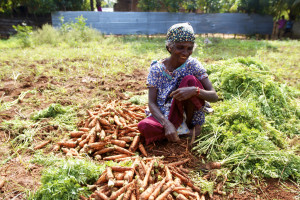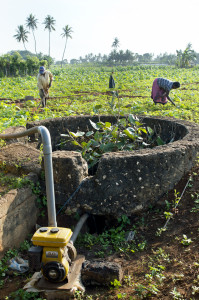Jaffna’s wells may not provide a year-round supply of clean water, but a mix of short and long-term options could provide communities with all the clean water they need,
says Dharshani Weerasekera
Has water replaced peace as the key to Jaffna’s progress? In the Jaffna Peninsula, in the northernmost part of Sri Lanka, the only source of fresh water for most of the year is that drawn from underground reservoirs. However, human activities are threatening these fragile and precious aquifers with contamination. Damage to this limited and irreplaceable resource would be extremely difficult or impossible to reverse. How can we ensure this does not happen?
The answer lies in how stakeholders address two major concerns. The first is groundwater contamination from the dumping of oil, sewage, agrochemicals and garbage into the ground. The second is the seawater intrusion of Jaffna’s limestone aquifers due to over-extraction of groundwater for domestic, agricultural and industrial purposes.
The rain falls mainly in the plain
In Jaffna, the monsoon rules. It determines most of the economic activities on the peninsula, from agriculture to tourism. The peninsula receives very little rainfall compared to the rest of the island, mostly during the North East monsoon from November to February. About 1,200mm of rain falls mainly in the Jaffna plain1. On this flat landscape, the rainwater percolates rapidly through the fine soil into underground cavities in the limestone, forming shallow aquifers. Of these, the Chunnakam aquifer is the principle one supplying Jaffna. One seasonal river, the Valukkai Aru, exists, but a great deal of the precipitation is lost to surface runoff and evaporation.
Jaffna’s residents therefore survive almost entirely on this groundwater, especially during the long dry season. Despite this constraint, the area is one of the most agriculturally productive in the country and shows the resilience of its communities. An International Water Management Institute (IWMI) study in 2012 shows an increase in the number of dug wells in the Valikamam area of Jaffna alone by about 37% between 2003 and 2009, even though land use for agriculture increased only by 6%. The number of wells in the area has increased dramatically and is estimated to be over 100,000. With increasing numbers and close proximity of wells will come increasing stresses on the quantity and quality of the available groundwater.

The area is developing rapidly since the end of the civil war in 2009. Infrastructure is being rebuilt and agriculture is booming. New industries such as local and foreign tourism, manufacturing and processing are bringing not only new opportunities but are also additional pressures on an already strained and limited water supply. Earlier industries such as ice plants for fisheries, water bottling, and cement production are operational once more.
A balancing trick
Year-round extraction is exceeding the rate at which the Chunnakam aquifer is recharged by the seasonal monsoon rains, making it highly vulnerable to being breached by seawater. In the East of the peninsula, the groundwater is already brackish or saline. Fertilizer, unavailable in the North during the civil war, is now used freely, but nitrogen-intense agricultural practices have polluted not just the Chunnakam aquifer but all other available freshwater as well. The balance is beginning to tip in the wrong direction.
Herath Manthrithilake, Head of the Sri Lanka Development Initiative at IWMI, says it is much more than a question of adequate water supply. “The biggest problem is for domestic and agricultural users. Contaminants from fertiliser, untreated sewage from households and hotels, garbage dumps, untreated hospital waste, and more recently, oil from a power plant, are causing serious health risks for residents,” he said. Among these are methemoglobinemia (blue baby disorder caused by contaminated food or drinking water) and oesophageal cancers caused by excess nitrate, and kidney stones caused by excess calcium compounds in drinking water1. Others include typhoid, cholera, infective hepatitis, diarrhoea, and worm infestation. Since the Jaffna limestone has no purification qualities, once pollutants enter the cavernous rock, they can spread throughout the aquifer.
Contaminants may affect agricultural production by causing plant diseases and reducing yields. If the aquifers in Jaffna are compromised, not only will communities and economies suffer, but natural eco-systems and the vegetation and wildlife they support will also be at risk.

Maintaining the delicate balance between the aquifer’s freshwater bubble and the surrounding saltwater as well as preventing further contamination requires careful governance. IWMI researchers, other experts and all major stakeholders in the region have agreed that a mix of options is best within a sustainable management system. It is hoped this will reduce related health problems and allow the aquifer to recharge. So what form will these take?
Safe potable water is the most urgent need. Raising awareness of the risks of sinking wells too close to latrines, and better municipal waste management are essential to reduce bacterial contamination. Recently, oil or grease was detected in the water at the Chunnakam intake point and in all the surrounding wells, and traced to the local power plant1. Although it has highlighted the serious issue of groundwater pollution, there was widespread social unrest and bouts of finger-pointing. Bowser-loads of drinking water were brought in but how quickly and extensively will the aquifer be polluted and agriculture affected? How long will it take for the rains to flush the water clear? Residents are demanding answers to these serious problems and short-term fixes may not be enough.
Increasing groundwater recharge in the aquifer will require both short- and long-term measures. Of these, demand management, reducing water wastage and re-using water are low-cost partial solutions. The most promising for the short-term is rainwater harvesting, by channeling rainwater from roofs into storage tanks for instance, and by restoring the more than 1000 ponds in the Jaffna Peninsula that capture rain and store rainwater. Once functioning, these ponds can play a dual role helping recharge the underlying aquifers too.
“There are no effective long-term solutions without an integrated plan incorporating efficient management of rainwater, wastewater, runoff as well as land use and resourceful irrigation. This needs central government decision making and local government action. We have the technological capacity,” says Manthrithilake, “but institutional and policy frameworks are weak.” Such challenges slow urgently needed progress. The Iranamadu project to supply some of the freshwater required for Jaffna has stalled. Another, the North Central Province Canal Plan, proposes to divert water from the Mahaweli River water to Vavuniya but will take several years to complete.
Speedy remedial measures are within grasp to allow rapid development of the peninsula to continue at significantly lower social and environment costs. Putting sustainable groundwater management quickly in place is essential to give Jaffna sufficient space and time to roll out its development plans for a bright future.
Dharshani Weerasekera is an independent writer. The International Water Management Institute (IWMI) has commissioned this article, but the views expressed are her own.

